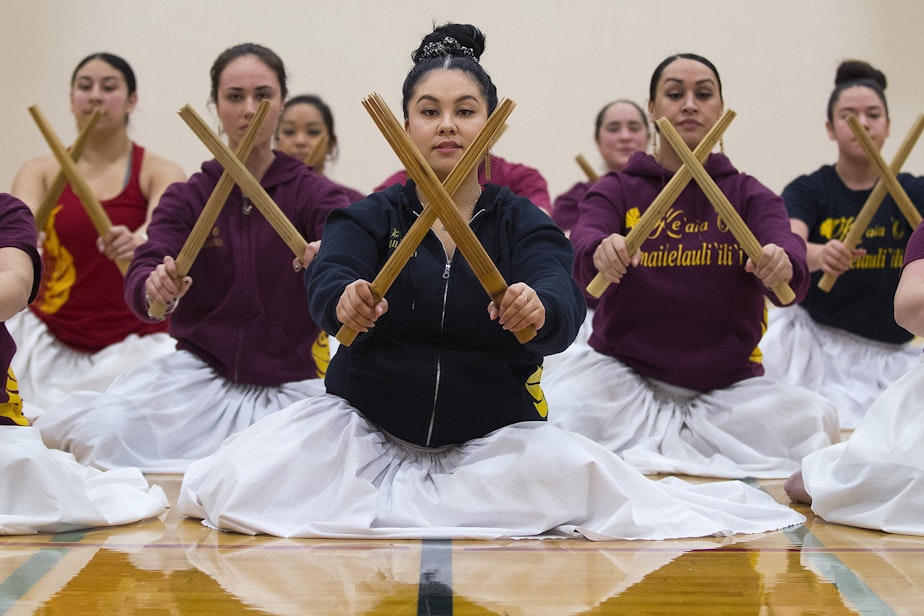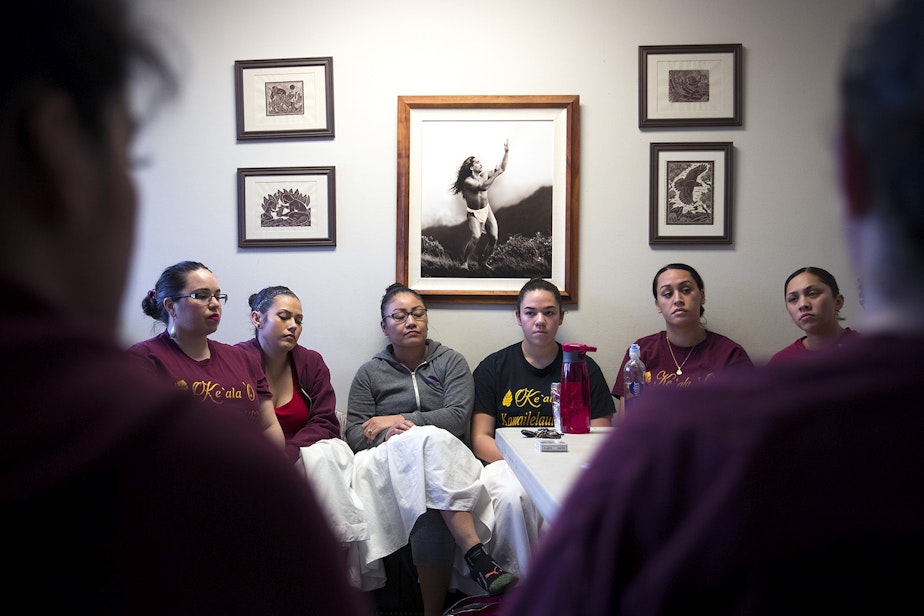Hula is way more than grass skirts, as these dancers will show you
When Kamaile Hamada found out last June that his group had been accepted into the world’s most prestigious hula competition, the first person he wanted to tell was his former hula partner, Sweetie Camacho.
“As soon as I hung up the phone, I went to visit Sweetie,” he says.
At her gravesite.
“I spent some time there, and of course, I cried,” he says. “Our goal finally came true.”
Before Camacho’s death in 2009, she and Hamada had a trip to Hawai`i’s Merrie Monarch Festival on their bucket list. For more than a half century, the annual competition in Hilo has featured the world’s best hula practitioners. Camacho and Hamada dreamed of bringing their students to compete.
“For everybody who’s grown up in Hawai`i, in hula, the Merrie Monarch stage is a goal. Once you get on it, you’re part of the who’s who in hula,” says Hamada.

Hamada has lived and breathed hula since his childhood on the island of Kaua`i.
“My mom taught me when I was small, then I went away to the Kamehameha schools,” he says. “That’s where I refined it.”
The Kamehameha schools were set up specifically for students of Hawaiian descent to get a general education, and learn about their own heritage.
After his schooling, Hamada’s mother told him he was ready to pass on his knowledge to the next generation, to become what’s called a “Kumu Hula,” literally “hula source.” As a Kumu Hula, Hamada oversees a Halau, which is essentially a school for not only hula, but the stories, chants and traditions that encompass Hawaiian culture.
“For white mainlanders,” he says, “hula is Hollywood. But real hula is the vehicle in which genealogy, history and stories, the vehicle in which they’re all preserved.”
Hamada oversees several dozen students who range in age from young children to elders who were raised in Hawai’i. On a recent rainy late winter evening, they’ve gathered after work in a high school gym to rehearse under his watchful eyes. The group has been working six days a week in preparation for the Merrie Monarch competition.

Three musicians holding percussion instruments crafted from gourds tap out the beat as Hamada begins to chant a story of the goddess Pele and her lover. Fourteen women in skirts and T-shirts, beating narrow wooden sticks, chant along with him as they dance what’s called a “kahiko,” an ancient form of hula developed before Western traders and missionaries arrived on the islands.
Hawai`i’s history is documented and disseminated through hula. The islands’ earliest settlers traveled from Polynesia centuries ago. They established villages and began to farm the volcanic islands. The leaders, Ali`i, were charged with providing for their followers; the various Hula Halau existed with their support. These stories, along with legends of various gods and other lore, are preserved and perpetuated through songs, chants and hula. According to Kumu Hula ʻIwalanikamakaheleiikapuamaeʻoleekalā Christian, of Brier, hulas differ a bit from island to island. Each Kumu is charged with correctly transmitting the particular hula tradition they were taught.

“None of it was written,” Christian says. “All of the events, all of the important happenings, all of the celebrated places, were all put to the oral tradition.”
Christian missionaries arrived in Hawai`i in the early 19th century and ultimately suppressed the hula, which they called a “heathen dance.” But Hawai`i’s last king, David Kalakaua, revived the public practice of hula by presenting it at his coronation. Nevertheless, once Americans assumed control of the island nation in 100 years later, they strongly discouraged traditional cultural expressions, including the Hawaiian language itself.
Most people who grew up outside Hawai`i know of hula through 20th century movies and television shows, featuring beautiful women in grass skirts and bikini tops swaying to ukulele music.
“That comes first to mind,” says Christian. “Hollywood hula, and tourist hula. Then there is what I call backyard hula, that’s the hula shared for family events, graduations, impromptu gatherings. I grew up with these.”

So did many mainlanders of Hawaiian descent. Sweetie Camacho’s daughter, Tanya Camacho Jose, was born in San Diego and raised in Washington State. Although her mother and grandmother practiced hula, she didn’t start until 2001, as a young adult.
“I only knew a little about hula,” she says, “but not the full extent of our history until the Halau here, because that’s what Kamaile teaches, the old traditional ways.”
She is excited, and a bit nervous, about participating in her first Merrie Monarch Festival. Jose feels she and her fellow dancers not only represent their own Halau; they also have to represent Hawaiians who’ve left the islands for new lives on the mainland.

“This is huge for us,” Jose says. “We’re the first Halau from Washington State to go. We have to bring it, we have to say, ‘Look at us, the Hawaiian culture is flourishing in Washington, where you probably didn’t think it was.’”
Tanya Camacho Jose, Kamaile Hamada and the rest of the Federal Way group compete in two categories at the 2018 Merrie Monarch festival in Hilo, Hawai`i.

